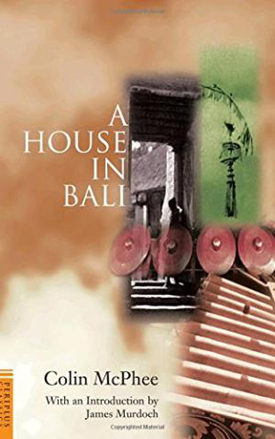 Colin McPhee, a Canadian-American composer who had much more influence on American music than the body of his music might indicate (see Colin McPhee: Composer in Two Worlds by Carol J. Oja), left behind two books that were as influential, if not more so, than his compositions: Music in Bali, published two years after his death, in 1966, a monumental work replete with musical illustrations and transcriptions of Balinese music, still a primary reference for musicians; and A House in Bali, a charming and perspicacious memoir of his years in Bali in the 1930s.
Colin McPhee, a Canadian-American composer who had much more influence on American music than the body of his music might indicate (see Colin McPhee: Composer in Two Worlds by Carol J. Oja), left behind two books that were as influential, if not more so, than his compositions: Music in Bali, published two years after his death, in 1966, a monumental work replete with musical illustrations and transcriptions of Balinese music, still a primary reference for musicians; and A House in Bali, a charming and perspicacious memoir of his years in Bali in the 1930s.
McPhee had heard recordings of Balinese music in the late 1920s and was completely captivated by the shimmering textures and subtle, complex rhythms. In 1931, he headed for Bali, where he spent most of the next seven years, building a house in a mountain village and immersing himself in the life and music of the island.
Those who have any familiarity with McPhee’s life know that he was at this time married to Jane Belo, who supported him during their stay on the island, even after their divorce in 1937, which perhaps explains why he did not return to Bali after World War II: he no longer had the means to live independently. What is somewhat surprising is that nowhere is she mentioned in the book: to all intents and purposes, he was there on his own. Nor is there reference to Margret Mead and Gregory Bateson, with whom McPhee and Belo worked more or less closely, finding that their various researches had many meeting points, and only the barest mention of Walter Spies, the German artist with whom McPhee worked closely and who became an intimate friend. Nor are there any overt references to McPhee’s affairs with Balinese men, supposedly the final cause of his divorce from Belo (although she knew of his orientation when they were married, and a perceptive reader can easily fill in many blanks).
The obvious explanation for these omissions is simply that the book is much less about McPhee than it is about Bali: McPhee was a gifted writer as well as composer, and the people and their lives become vividly real. And, it is mostly about the music, about its means, its methods, and its place in Balinese life.
McPhee seems to have had a deep, almost innate sympathy for Bali and the Balinese. Although the period between the World Wars was the great age of the American expatriate, most of them seemed to cluster in Paris, Berlin, or Mexico City, and, while Bali was a popular tourist spot for wealthy Americans in the 1930s, almost none spent any time there. McPhee approaches his time in Bali with respect and passion: gracefully and without didacticism, he paints a detailed picture of the ritual and social context of Balinese life, many aspects of which still seem, to a Westerner, barely comprehensible. (The idea that the drama involves plays in which one may not know exactly which story is being told until several hours into the performance – if ever – still strikes us as odd; to the Balinese, with their rich cultural tradition and almost complete lack of distinction between music, drama, dance and worship except as facets of a sparkling whole, it is perfectly normal. I suspect it must be akin to the context of the ancient skalds or poets of Europe performing well-known stories of Beowulf or Odysseus: everyone knew the story; the excitement was in the immediate experience and the particular elaborations and grace notes, turns of phrase or new elements, that a poet would add.)
We also learn, without quite realizing it, a great deal about the teaching of music and dance, about the passage of tradition from generation to generation. At most, the “core” of a musical composition might be written down, a few notations that mark the progression of the melody. The rhythms, the embellishments (the “flowers”), the style are left up to the musicians. (A note on the subconscious: somehow, the word “musicians” in this sentence came out initially as “magicians”; I think this might actually be true. Anyone who has listened to Balinese music will probably back me up.) The normal practice was (and probably still is) for the composer of a new work to teach it to the gamelan, probably a club of which he is a member. There is much less talking than in American pedagogy, much more demonstration, much more direct guidance: McPhee relates several instances in which the teacher doesn’t speak at all, but just repeats a phrase for the gamelan until it is learned, then adds another, and then another, until a new composition has made its way into the orchestra’s repertoire. It is similar in dance, although American practice in this regard is much closer to Balinese, as, I suspect, it must be – words, in this area, are inadequate.
There is a fair amount of humor in the book, most of it from the collision of Balinese attitudes and Western expectations, some of it quite surreal. McPhee is a gentle commentator, although with enough acerbity to keep the narrative from ever becoming bland, and A House in Bali is a graceful and ultimately fascinating picture – and perhaps one much truer than any anthropologist has managed so far – of life in Paradise.
(Oxford University Press, 1986 (orig. pub. Victor Gollancz, Ltd., 1947)
